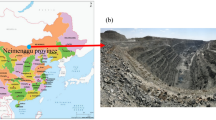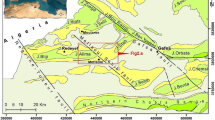Abstract
A volcanic slope in Izu Oshima Island in Japan experienced a profound rain-induced disaster in October 2013. Since this slope had been stable for centuries except for minor failures, a special investigation was carried out on the cause. Because of its volcanic origin, the failed slope consisted of layers of ash, sand and lava. While the investigation concerned many disciplines, the present paper addresses one part of the geotechnical studies. The particular emphasis was put on the reason why some part of the slope “did not” fail because the post-disaster construction of infrastructures in the affected area relied on the future stability of the affected mountain slope. In line with this, another focus of the study was on the geohydrological feature of the underlying lava layer that possibly controlled the instability of the volcanic slope. It was concluded finally that the lava layer is pervious and allows drainage of infiltrated rainwater and that, only during extremely heavy rain, the subsurface lava topography triggered slope failure only in its “valley” parts. For 7 years after the disaster, the remaining parts of the slope have been stable as judged and many local infrastructures have been reconstructed.






































Similar content being viewed by others
References
Baum RL, Godt W (2010) Early warning of rainfall-induced shallow landslides and debris flows in the USA. Landslides 7(3):259–272
Brunetti MT, Peruccacci S, Rossi M, Luciani S, Valigi D, Guzzetti F (2010) Rainfall thresholds for the possible occurrence of landslides in Italy. Nat Haz Earth Syst Sci 10(3):447–458
Caine N (1980) The rainfall intensity: duration control of shallow landslides and debris flows. Geografiska annaler: series A, physical geography. Svenska Sallskapet för Antropologi och Geografi (Swedish Soc Anthropol Geogr) 62(1/2):23–27
Campbell RH (1975) Soil slips, debris flows, and rainstorms in the Santa Monica mountains and vicinity geological survey professional paper. US Geological Survey Professional Paper, Southern California, p 851
Committee for Publication of Oshima's History (2000) General Summary of Oshima History, p.765 (in Japanese).
De Vita P, Napolitano E, Godt JW, Baum RL (2013) Deterministic estimation of hydrological thresholds for shallow landslide initiation and slope stability models: case study from the Somma-Vesuvius area of southern Italy. Landslides 10(6):713–728
Disaster Prevention Board of Tokyo Metropolitan Government (1990) Characteristics on volcanic activities in Izu Archipelago, p.40 (in Japanese).
Endo T (1969) Probable distribution of the amount of rainfall causing landslides, Annual Report 1968, Hokkaido Branch, Government Forest Experiment Station, 122-136 (in Japanese).
Ichinose Y (1960) On landslides at Tara Volcano, northern Kyushu. Geogr Rev Japan 33(10):515–528
Inokuchi T (2003) General report of research on landslide disaster in quaternary volcanic areas. J Japan Landslide Soc 40(1):1–9 (in Japanese)
Japan Meteorological Agency (1958) Kanogawa typhoon. Technical Report, 37, p.140 (in Japanese).
Kinoshita N, Abe T, Takemura T, Yokomoto S (1993) Investigation of hydraulic properties in rock mass around tunnels using injection test. 25th Rock Mechanics Symposium, JSCE: 481–485 (in Japanese).
Koyama M, Hayakawa Y (1996) Syn- and post-caldera eruptive history of Izu Oshima volcano based on tephra and loess stratigraphy. J Geogr Tokyo Geogr Soc 105(2):133–162 (in Japanese)
Lavigne F, Thouret JC (2003) Sediment transportation and deposition by rain-triggered lahars at Merapi volcano, Central Java. Indonesia Geomor 49(1–2):45–69
Matsushi Y, Saito H, Fukuoka H, Furuya G (2013) Landslides of tephra deposits on hillslopes of the Aso Caldera wall and volcanic central cones by the North-Kyushu heavy rainfall at July 2012. Annu Disaster Prev Res Instit Kyoto Univ 56B:237–241 (in Japanese)
Nakai S, Kaibori M, Sasaki Y, Moriwaki T (2007) Applicability of a new rainfall index R′ for recent cases and proposal of the method for warning against sediment-related disaster. J Japan Soc Eros Control Eng 60(1):37–42
Nakamura K (1964) Volcano-Stratigraphic Study of Oshima Volcano, Izu. Bull Earthq Res Instit Univ Tokyo 42(4):649–728 (in Japanese)
National Research Institute for Earth Science and Disaster Resilience (2013) Records of ground shaking induced by slope disaster in Izu Oshima Island. Report, https://www.bosai.go.jp/saigai/2013/img/20131021_02.pdf retrieved on January 19, 2019 (in Japanese).
Nolasco-Javier D, Kumar L, Tengonciang AMP (2015) Rapid appraisal of rainfall threshold and selected landslides in Baguio, Philippines. Nat Haz 78(3):1587–1607
Ogiso M, Yomogida K (2015) Estimation of locations and migration of debris flows on Izu-Oshima Island, Japan, on 16 October 2013 by the distribution of high frequency seismic amplitudes. J Volcanol Geoth Res 298:15–26
Onodera T, Yoshinaka R, Kazama H (1974) Slope failures caused by heavy rainfall in Japan. J Japan Soc Eng Geol 15(4):191–200
Osanai N, Shimizu T, Kuramoto K, Kojima S, Noro T (2010) Japanese early-warning for debris flows and slope failure using rainfall indices with radial basis function network. Landslides 7(3):325–338
Oshima Municipal Government (2016) External committee report on sediment disaster in Izu Oshima Island in 2013, https://www.town.oshima.tokyo.jp/uploaded/life/1421_1711_misc.pdf retrieved on Jan. 17, 2019 (in Japanese).
Pagano L, Reder A, Rianna G (2014) Experiments to investigate the hydrological behaviour of volcanic covers, the third Italian workshop on landslides. Proced Earth Planet Sci 9:14–22
Paguican EMR, Lagmay AMF, Rodolfo KS, Rodolfo RS, Tengonciang AMP, Lapus MR, Baliatan EG, Obillem EC (2009) Extreme rainfall-induced lahars and dike breaching, 30 November 2006, Mayon Volcano, Philippines. Bull Volcanol 71(8):845–857
Piciullo L, Gariano SL, Melillo M, Brunetti MT, Peruccacci S, Guzzetti F, Calvello M (2017) Definition and performance of a threshold-based regional early warning model for rainfall-induced landslides. Landslides 14(3):995–1008
Saucedo R, Macías JL, Sarocchi D, Bursik M, Rupp B (2008) The rain-triggered Atenquique volcaniclastic debris flow of October 16, 1955 at Nevado de Colima Volcano, Mexico. J Volcanol Geoth Res 173(1–2):69–83
Scott KM, Macías JL, Naranjo JA, Rodriguez S, McGeehin JP (2001) Catastrophic debris flows transformed from landslides in volcanic terrains: mobility, hazard assessment and mitigation strategies. USGS Professional Paper, No. 1630
Segoni S, Piciullo L, Gariano SL (2018) A review of the recent literature on rainfall thresholds for landslide occurrence. Landslides 15:1483–1501
Terlien MTJ (1998) The determination of statistical and deterministic hydrological landslide-triggering thresholds. Environ Geol 35(2–3):124–130
Tokyo Metropolitan Government (2014) Report of Committee on disaster mitigation plan after slope disaster in 2013 (in Japanese).
Towhata I, Uchimura T, Seko I, Wang L. (2015) Monitoring of unstable slopes by MEMS tilting sensors and its application to early warning. International Symposium on Geohazards and Geomechanics, Warwick, IOP Conference Series: Earth and Environmental Science.
Tsuiki T (1961) Study on history of Izu Oshima. Special committee for publication (in Japanese)
Uchimura T, Towhata I, Wang L, Nishie S, Yamaguchi H, Seko S, Qiao JP (2015) Precaution and early warning of surface failure of slopes by using tilt sensors. Soils Found 55(5):1086–1099
Wang G, Jiang Y, Chang C, Doi I, Kamai T (2019) Volcaniclastic debris avalanche on Motomachi area of Izu-Oshima, Japan, triggered by severe storm: phenomenon and mechanisms. Eng Geol 251:24–36
Acknowledgement
The present study was conducted as an emergency investigation after the disaster by establishing a task committee with a financial support from the Ministry of Education, Culture, Sports, Science and Technology. Because the studied area belonged to a national park under strict protection of nature, deep appreciation is expressed to the permission and support by those related public sectors such as the Tokyo Metropolitan Government, Oshima Municipal Government, Ministry of Environment and Geopark of Oshima (Mr. A. Kajiya). In particular, the borehole data provided by the Tokyo Metropolitan Government were essential in safety judgment of the slope. The collaboration was successfully made by four academic societies which are Japanese Geotechnical Society, Japan Society of Civil Engineers, Japan Society of Engineering Geology and Japan Landslide Society. Boring investigation on site was carried out by Chisui Kaihatsu Company. Those supports and collaboration are deeply appreciated. Then, last but not least, many more members of the task committee made important studies together with the authors and suggested valuable issues. Special thanks are dedicated to them.
Author information
Authors and Affiliations
Contributions
The authors worked as a team to carry out this study.
Corresponding author
Ethics declarations
Conflict of interest
The authors declare that they have no conflict of interest.
Additional information
Publisher's Note
Springer Nature remains neutral with regard to jurisdictional claims in published maps and institutional affiliations.
Rights and permissions
About this article
Cite this article
Towhata, I., Goto, S., Goto, S. et al. Mechanism and future risk of slope instability induced by extreme rainfall event in Izu Oshima Island, Japan. Nat Hazards 105, 501–530 (2021). https://doi.org/10.1007/s11069-020-04321-0
Received:
Accepted:
Published:
Issue Date:
DOI: https://doi.org/10.1007/s11069-020-04321-0




